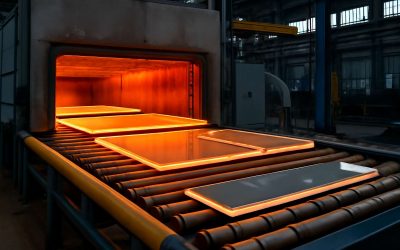
Tempering is a process that increases the strength and durability of glass. This is important in the manufacturing process because it allows glass to be incorporated into various components without fear of breaking or component failure. Tempering makes glass suitable for a wide variety of applications, including lighting, kitchenware, and even appliances and laboratory equipment. In fact, tempered glass has become the standard for many applications.
Tempering involves heating and cooling glass rapidly and uniformly, thereby strengthening it. The temperature needed to achieve this varies depending on the mass and type of glass. During tempering, the outer layers of glass are cooled faster than the center, which produces a tension effect. Afterwards, the center of the glass is cooled as well.
To start the process, the glass must be cut into the desired shape. The edges of the glass must be polished before putting the glass in the tempering oven. A rotary tool like a Dremel tool or a hand sander can be used to remove sharp edges. Once the glass is heated to a high enough temperature, it is quenched, which produces a dramatic shock that strengthens the material.
After the tempering is finished, the glass is cooled quickly. It is important to keep the surface of the glass cool at all times, which is achieved through a high pressure cooling procedure called quenching. Quenching is performed with a blast of air. As the surface of the glass cools, it pulls away from the outer layers of glass, resulting in a stronger and more durable material.
When the glass has reached the desired level of temperature, it is then placed in a tempering oven. This is a furnace designed specifically for tempering. Heat is provided by an electric element. It provides a consistent temperature and thermal precision, which is required to prevent glass from self-exploding.
Tempered glass is a durable and durable product that is ideal for residential and commercial settings. It has improved tensile strength and resistance to bending. It is also a great choice for safety applications. For example, it is widely used in car windshields and rear windows, in high-pressure windows, and in explosion-proof lighting applications.
Tempered glass is also available in different shapes. The process of shaping tempered glass can be done manually or by using an automatic glass bending unit. These units are controlled by a servo motor. By using the machine, the edges of the glass can be shaped in an array of styles.
Tempered glass can be manufactured in any size, shape, or color. However, it is recommended that glass manufacturers use the optimum size and shape for the application. If the glass is too small or too large, it can break. This can result in significant costs. Therefore, it is crucial to get the right information from glass manufacturers. Check the specifications for all components. You can do this by comparing the information with minimum values.
Tempered glass is also known as safety glass. It can be used in a wide range of applications, from kitchenware to appliances, from furniture to doors, and even fire-resistant lighting.



0 Comments